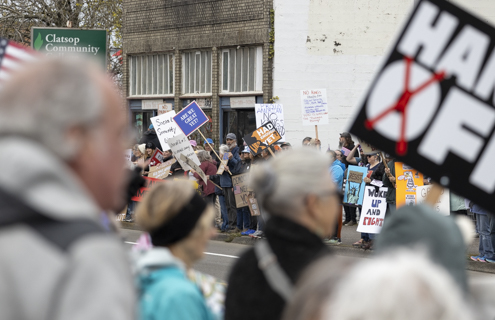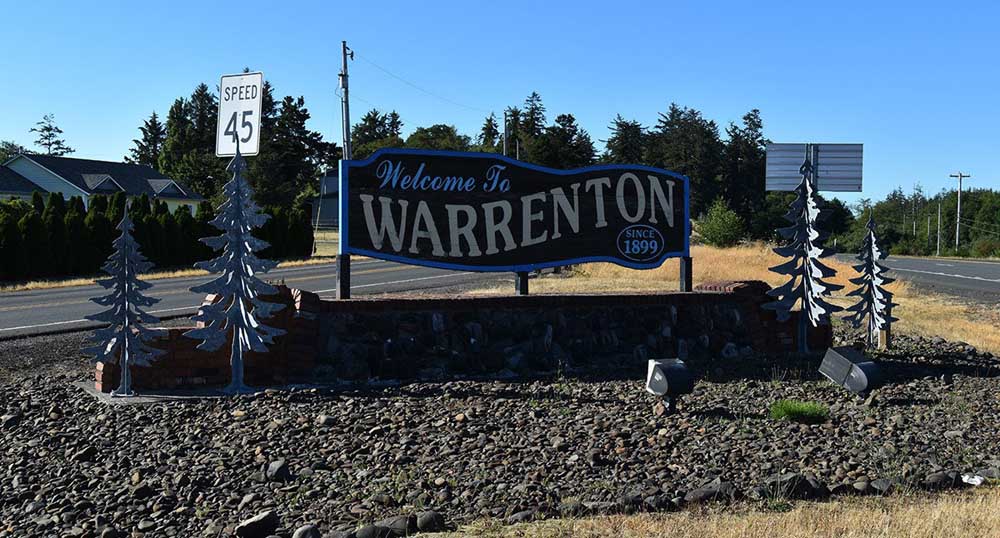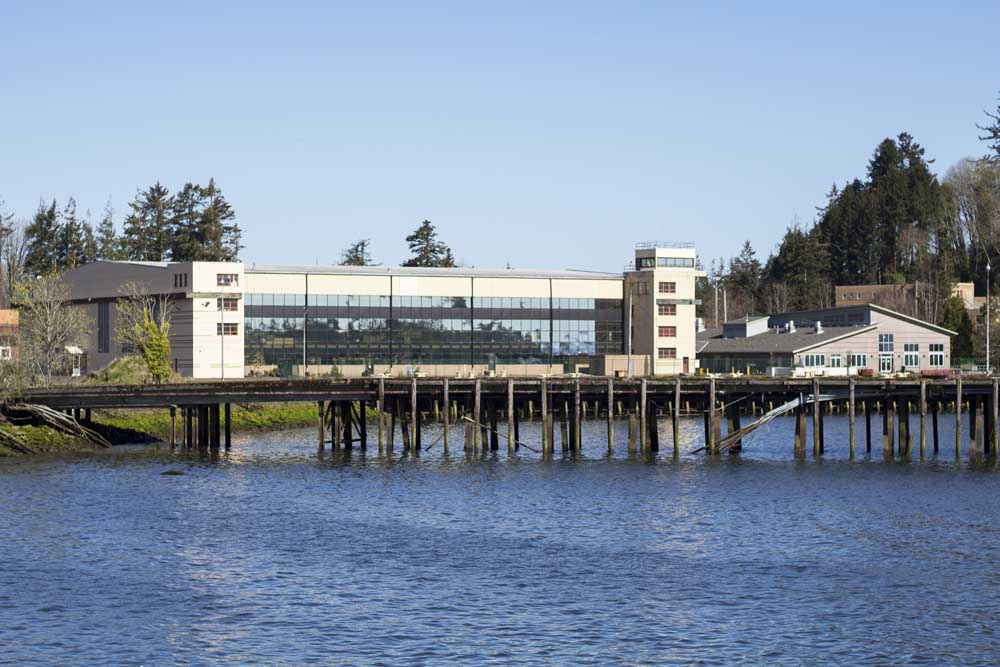Without Noreen Robinson there would be no Ilwaco museum
Published 4:00 pm Thursday, January 11, 2007
In the 1950s, fishing and timber were king. The Willapa Hills in Pacific County, Wash. could still boast more old-growth timber than second growth. Hobe Kytr of Astoria writes about Noreen Robinson growing up in a family logging camp west of Vernonia.
Robinson grew up in an environment of cross-cut saws or gigantic saber-tooth-like blades from defunct saw mills that once defined the rivers and estuaries of the Pacific Northwest and her determination is attributable to the grit of these timber pioneers.
The Coast Range and the Tillamook Burn areas were vast in the early 1900s, and the men who logged those forests had traditional values: women should stay home and raise children. Robinson spent her life fighting that concept.
She inherited much of the same brand of toughness as her ancestors, her later successes were coupled with a common-sense approach to life as well as a soft-spoken persuasion. She was a one-woman tour de force. As far as the city of Ilwaco, Wash., goes, there have been few equals.
Robinson was the Ilwaco Heritage Museum. She transformed the old Ilwaco Telephone Utilities building into a museum that would have pleased any major metropolis. Initially, the idea belonged to her and the mayor, Les Peterson, an ex-logger, and a man of determination and vision. However, the inception, vision and budgeting of the project would become hers. Though assisted by wonderful citizens and a supportive board – including later director Kytr – the inspiration and hallmark of its success is directly attributable to Robinson’s early vision. She gathered dollars, donated long hours, and when any effort fell short, personally donated additional cash, inspiration and commitment. God only knows how she raised and educated her four children from the humble profits of a small laundry, but determination, and her husband’s support, carried the day.
Until 1964, The Robinson family lived on a homestead in rural Pacific County. Her oldest son, Bob, was raised in the house his parents built, and remembers how “Mom measured the beam points while Dad cut the rafters.”
The Robinson kids – Bob, Bill (who died in 2000), Margaret (Maggie) and Katherine – grew up at Sunshine Point, a small piece of rural heaven near the mouth of the Naselle River, a tributary that roils into Willapa Bay around that stunning old-growth refuge called Long Island. Their life was pioneer in nearly every aspect. Bob said his mother kidded that they were the first hippies. “I was 6 years old and got to turn lights on for the first time.” Bob didn’t always appreciate Mom’s values – “didn’t appreciate the simple clothes Mom sewed for me. I missed school more than once when I stayed home to pull a cow out of the Willapa Bay mud.” The Robinsons raised 25 head of cattle on their farm. Chickens with their pretty speckled eggs remained a staple. Bob was a grown man before he realized the benefits of such simple rural beginnings.
Robinson’s formative years took place in Portland, where she graduated from Grant High School. Near the end of World War II, a girlfriend introduced Noreen to George “Sie” Robinson. Sie was in the Navy and saw action on the USS Trenton.
After three years at Oregon State, Noreen was accepted into Reed College. Though her parents had other hopes for her, she married back into the logging profession when she fell head-first for Sie. That year, she ran away with the sailor and homesteaded on the Naselle River. Her mother was crushed. The disappointment carried on for years, with a cruel separation between mother and daughter. Bob projects that there were times as his mother matured, that she too felt the sharp cutting edge of her rebellion. A degree in chemistry from Reed was no small matter for a woman in the 1940s. Robinson demonstrated she was a capable student. What-ifs haunted her maturity.
Sie was a man of the land. According to Bob, Sie’s grandfather’s wife was a member of the Chinook tribe. For years Sie lived close to the land, hunting, fishing and trapping, as his father did before him. He took jobs in the woods, and when injuries sidelined his earning capacity, the family lived off what the land provided. He died in 2004.
Robinson founded an adult educational program through Grays Harbor College. Founded the River City School of Arts, Crafts and Dance. She and Edie Shire championed the concept of the Peninsula Church Center, and worked diligently toward its fruition.
She was responsible for reviving the annual cranberry fair in Ilwaco. She donated property adjacent to the Ilwaco Heritage Museum that allowed its expansion. What the museum needed, she bought. There was no budget for extras. Robinson served on the Ilwaco City Council (1978 to 1993) and worked with the school board and local chambers of commerce. In 1986, she was a recipient of the Outstanding Volunteers Award by Gov. Booth Gardner.
Robinson extended a calm demeanor and a helping hand to others in need. In 1996, she was nearly killed in an accident. Thrown from her car in a head-on collision on the Astoria Bridge, Robinson, who had already overcome polio, refused to surrender to any disability.
Her contribution to Ilwaco was almost overwhelming
The following tributes to Noreen Robinson appeared in The Daily Astorian and the Chinook Observer after her death in May 2006.
By NANCY BUTTERFIELD
East Oregonian Publishing Group
ILWACO, Wash. – Noreen Robinson, “the matriarch of Ilwaco,” died in May, 2006. She was 80.
A woman who never took no for an answer, Robinson was known as a visionary who brought to reality almost super-human projects for her city.
“You don’t have to go far to see her mark on this community,” said Ilwaco Mayor Doug Hubbard. She was appointed to the Ilwaco City Council in 1978 and won every election after that, serving until 1993.
Robinson is known for founding the Ilwaco Heritage Museum, at one point selling hot dogs on the beach and at ball games to raise money to refurbish the old Ilwaco Telephone Utilities building. A long-time Ilwaco resident said Robinson worked with the Smithsonian Institution on how to establish a museum.
“If not for her, there would be no Ilwaco Heritage Museum,” said museum Director Nancey Olson. “That’s the kind of vision she had for the city of Ilwaco. She wanted to see Ilwaco grow and prosper. She wasn’t just a visionary, she was a doer. She’d come up with an idea and knew how to follow through and get the job done. She had a huge heart and a giving spirit. Her energy, time and devotion will be missed.”
“She was one remarkable woman,” former museum director Hobe Kytr. “She was a tough old gal and had more life than a nine-lived cat. She did a world of good for the community and made it incredibly richer for her presence with her diligence and sense of civic duty.” Robinson “was there to serve everybody,” he said.
During the Ilwaco City Council meeting following her death, a number of people, including Hubbard and Councilman Dave Fritts, who served both with Robinson on the council, spoke of the impact she had on the city.
Fritts, who served with Robinson on the council more than 20 years ago, said she talked him into running for office. She was “the landmark of the town,” he said. “She will never be replaced. She was very creative, she was a visionary, she could see things that could be done way before anyone else could see them and she had the determination to get it done. She could get more done in an afternoon in a coffee shop than most people could do in a year. If she set her mind to do something, it got done.”
Besides the museum and the River City School of Arts and Crafts and a number of other projects, Fritts said Robinson started the Loyalty Days children’s parade. “It’s a very big loss to Ilwaco,” he said. “She did a ton for everyone and everyone in town will miss her. She was a shaker and a maker, she made things happen.”
Councilman David Jensen said he worked with Robinson on the museum project. “She had great common sense and amazing artistic abilities,” he said. “She had the energy and ability for putting projects together.”
“Noreen reminded me of Margaret Thatcher,” former Ilwaco City Council member Shirley Burt said. “She was the ‘iron lady.’ She started the museum with virtually nothing and, like Topsy, it growed and growed. She accomplished so much for the city and she never wanted a fuss made over her. It’s a great loss for Ilwaco.”
Pacific County Commissioner Jon Kaino, who grew up in Ilwaco, said Robinson “was an icon of Ilwaco when I was a young kid and she’s been an icon ever since.”
Founding the River City School of Arts and Crafts was another example of Robinson’s determination. Sharon Saunders, president of the school’s board, said she was with Robinson “from Day 1” on the school, which began in 1999. “Noreen said ‘I’ve got an idea,’ and everybody jumped,” she said. “The first project we did together was the Ilwaco Learning Center, now the Grays Harbor College Annex, about 10 years ago.”
Saunders said Robinson’s death was “a real shock. It hit me so hard I can’t think about it. I’ll miss her terribly. All the things I’ve learned professionally, Noreen was my mentor. She said ‘There’s nothing you can’t do if you put your mind to it. You do things not for what you get but for what you can give.’ She changed my whole outlook on life. She taught me what community service is about. If you do that, you can live life like Noreen Robinson and love what you’re doing.”
“She was our institution and was from way back,” Karla Nelson, owner of Time Enough Books at the Port of Ilwaco, said. “She was always there for supporting kids’ programs. If she had a vision, she just went out and did it. There was no ‘no’ for her. Nothing was impossible.”
Ilwaco Volunteer Fire Department Chief Tom Williams said Robinson was instrumental in getting an addition built on the fire station and also helped secure funding to establish the city’s Fire Museum.
“She was a true believer in Ilwaco, even when we were on a downhill slide,” he said. “She stuck with it and tried to keep the town going and prosper. She and her husband, George Hampton “Sie” Robinson, did a lot for the town. They volunteered on the library and cemetery boards and worked day and night to make the museum work.”
He said he remembers going to the Peninsula Cleaners when he was a child. The business was started by Robinson’s mother, Noreen Walters, who constructed the building, and was continued for many years by Robinson after Walters died in 1974.
Her son Bob Robinson recalled Tuesday that Noreen was a “volunteer all her life,” getting her start in community activism by helping found the Peninsula Church Center in Seaview. A self-taught grant-writer, she had great success in attracting funds for our area.
She was born July 1, 1925 at Mercy Hospital in Eugene, attending Grant High School in Portland and Oregon State College before marrying Sie on June 30, 1948. They soon moved to the family homestead in the Naselle area, later relocating to Ilwaco in 1963-64.
Sie preceded his wife in death on Nov. 21, 2004, as did the couple’s son William in 2000. In addition to her son Bob of Sheldon and Ilwaco, Robinson is survived by her daughters, Margaret Pace of Washougal and Kathryn Fleischman of Lebanon; 15 grandchildren and six great-grandchildren.





